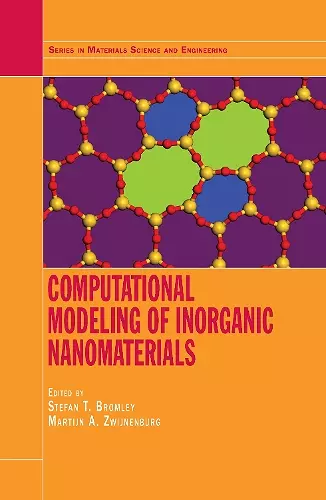Computational Modeling of Inorganic Nanomaterials
Stefan T Bromley editor Martijn A Zwijnenburg editor
Format:Paperback
Publisher:Taylor & Francis Ltd
Published:31st Mar '21
Currently unavailable, and unfortunately no date known when it will be back
This paperback is available in another edition too:
- Hardback£190.00(9781466576414)

Computational Modeling of Inorganic Nanomaterials provides an accessible, unified introduction to a variety of methods for modeling inorganic materials as their dimensions approach the nanoscale. With contributions from a team of international experts, the book guides readers on choosing the most appropriate models and methods for studying the structure and properties (such as atomic structure, optical absorption and luminescence, and electrical and heat transport) of a varied range of inorganic nanomaterial systems.
Divided into three sections, the book first covers different types of inorganic nanosystems with increasing dimensionality. The second section explains how to computationally describe properties and phenomena associated with inorganic nanomaterials, including the modeling of melting and phase transitions, crystallization, and thermal, mechanical, optical, and excited state properties. The final section highlights a diverse range of important recent case studies of systems where modeling the properties and structures of inorganic nanomaterials is fundamental to their understanding. These case studies illustrate the use of computational techniques to model nanostructures in a range of applications and environments, from heterogeneous catalysis to astrochemistry.
Largely due to their extremely reduced dimensions, inorganic nanomaterials are difficult to characterize accurately in experiments. Computational modeling, therefore, often provides unrivaled, detailed insights to complement and guide experimental research on these small-scale materials. This book shows how computational modeling is critical for understanding inorganic nanomaterials and their future development.
"The editors have delivered on their promise of a readable text, accessible to newcomers and useful for experts. This is not a random collection, but indeed a coherent book, very accessible and very useful. Its inner coherence and well-tempered quality match single-author textbooks, and it covers everything, from basic introductions to expert applications."
—Professor Dr. Bernd Hartke, Institute for Physical Chemistry, University of Kiel
"… an inspiring, accessible, yet authoritative read for undergraduates to seasoned simulators."
—Dr. Dean C. Sayle, School of Physical Sciences, University of Kent
"This engaging book provides an introduction to the field of computational nanoscience, using topical cases studies on some of the most commercially important inorganic nanomaterials. It will be a valuable resource for graduate students seeking to join our community, or more broadly for other researchers who want to understand how and why we do what we do."
—Dr. Amanda S. Barnard, Office of the Chief Executive (OCE) Science Leader, CSIRO
"… an excellent and logically structured overview written by renowned researchers in the field. This uniquely themed book provides a much-needed introduction to modeling the structure and properties of nanomaterials and further provides real case studies showing where nanomaterial modeling is important. The book is suitable for a range of readers, from undergraduate to research level, and would provide ideal pedagogical support for graduate courses involving materials modeling and/or computational nanoscience."
—Professor Dr. Francesc Illas, Department of Chemical Physics and IQTCUB, University of Barcelona
"… an invaluable guide both to those already working in the field of inorganic nanoscience and those entering this important area of contemporary science."
—From the Foreword by Professor Richard Catlow, FRS, University College London
ISBN: 9780367783044
Dimensions: unknown
Weight: 453g
423 pages